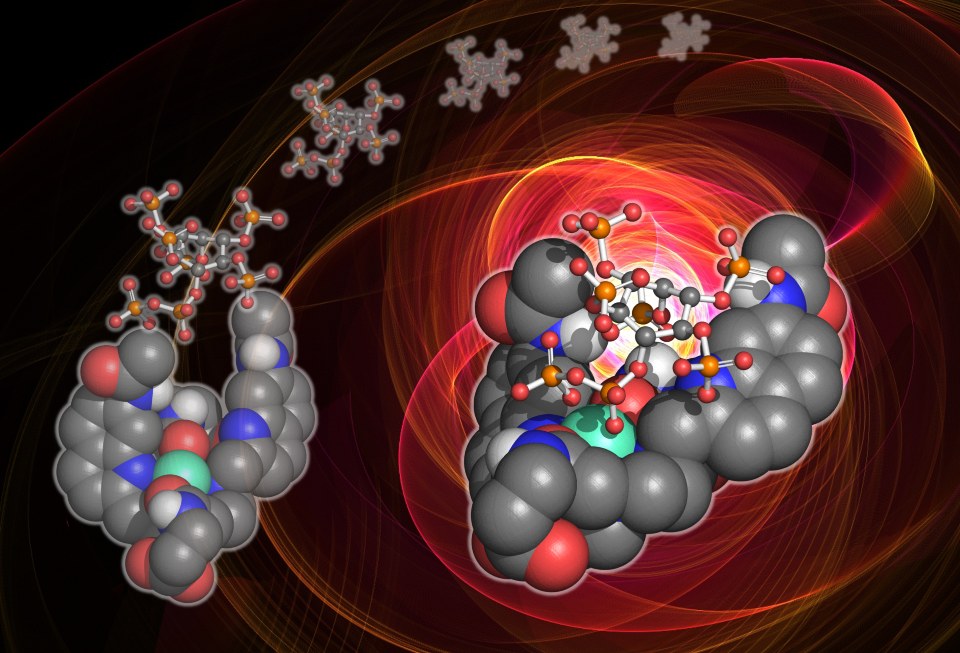The research paper – recently highlighted as Pick of the Week in the Royal Society of Chemistry’s flagship journal, Chemical Science – showcases the researchers’ innovative probe that binds to inositol pyrophosphate or ‘5-PP-InsP5’.
5-PP-InsP5 plays a fundamental role in various biological processes, including cell growth, programmed cell death, and enzyme regulation, and new roles are still emerging with it recently being found to be a key regulator of blood glucose levels.
Due to its diverse roles in cellular processes, 5-PP-InsP5 is an attractive target for developing therapeutic drugs.
However, biomedical and drug discovery research relies on ‘small molecule probes’ to detect specific target molecules and, until now, no 5-PP-InsP5-specific probes existed.
The Loughborough University and University of Oxford research team – which includes Dr Stephen Butler, Dr Felix Plasser, and Professor Barry Potter – combined their chemical synthetic and computational modelling expertise to create a probe specific to 5-PP-InsP5 that emits a bright red light upon binding.
The intensity and duration of this light can be measured to quantify the levels of 5-PP-InsP5 during different biological processes, paving the way for a deeper understanding of its precise functions, mechanisms, and therapeutic potential.
Of the importance of the research, Dr Stephen Butler commented: “A key motivation in our lab is to develop molecular tools with real-world applications, so we’re excited about the potential of the probe reported here as a drug discovery tool, that could enable high-throughput screening of drug-like molecules that modulate biological processes involving the cellular messenger 5-PP-InsP5.
“Other inositol pyrophosphates exist and are still emerging in biology, so methods to detect, synthesise and exploit these could also be necessary and will be facilitated by the probe design features established in this project.”
Professor Barry Potter, of the University of Oxford, added: “I have spent almost all of my independent scientific career in research on inositol phosphates and feel that the advent of these new pyrophosphate messengers, with their emerging biological functions, is truly exciting for the field and calls for innovation.
“Our highly collaborative new paper presents a very timely technique to measure such a messenger for the first time and should enable a wealth of further developments in the area.”
The co-lead authors of the study are Megan Shipton and Fathima Jamion, a PhD and final year undergraduate student from Oxford and Loughborough, respectively.
Megan and Fathima said of their achievement in a joint statement: “We are delighted to work as part of this collaborative team to take some vital steps in helping further uncover the biological roles of 5-PP-InsP5.
“It’s especially rewarding to see our combined work published in a top chemistry journal and we look forward to seeing how it fuels future research in this area.”
The research paper, titled Expedient synthesis and luminescence sensing of the inositol pyrophosphate cellular messenger 5-PP-InsP5, was funded by the UKRI Biotechnology and Biotechnological Sciences Research Council (Butler) and The Wellcome Trust (Potter).
It can be read in its entirety on the Chemical Science webpage.
More information on Dr Butler’s work can be found on his research group website. He is pursuing commercialisation of selected luminescent probes as new bioassay technologies and has developed a patented hydrogel material, in collaboration with Loughborough University’s Dr Helen Willcock to encapsulate a variety of probes for monitoring specific ion levels in samples in real-time.
More details on Professor Potter's research interests are available on his website. Aside from his work on inositol phosphates he has designed and synthesised novel drugs and brought them to many international clinical trials in both male and female cancer patients with evidence of clinical benefit.
